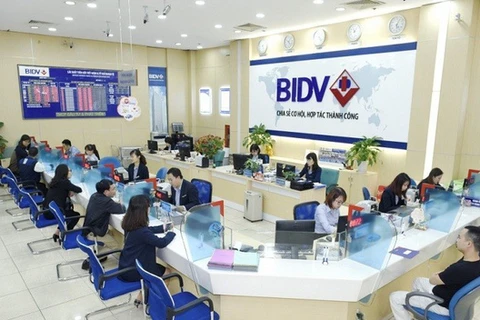Hanoi (VNA) - The banking sector has recorded many important hallmarks in 2019, especially the adjustment of a series of policies to help stabilise credit institutions.
The year 2019 witnessed flexible monetary policies to ensure goals. Especially, in the last 3 months of the year, the State Bank of Vietnam continuously made adjustments, which are considered steps to create a foundation for 2020.
In addition, foreign exchange reserves and remittances hit record levels, credit growth was curbed, and digital banking technology strongly developed.
Repeated interest rate adjustments
In September, the State Bank of Vietnam fired the first shot with a decision to lower the interest rate for the first time since 2017. Accordingly, the refinancing interest rate decreased from 6.25 percent to 6 percent per year and the rediscount rate dropped from 4.25 percent to 4 percent per year.
A short time after, in November, the central bank continued to make changes to the ceiling deposit and lending rates. On November 18, it suddenly issued a notice on adjusting the maximum interest rate applicable to non-term deposits and those with terms from 1 month to less than 6 months from 5.5 percent per year to 5 percent per year. Along with that, the maximum interest rate applied to non-term deposits and those with terms from 1 month to less than 6 months at people's credit funds and microfinance institutions decreased from 6 percent to 5.5 percent per year.
The State Bank of Vietnam’s next policy related to interest rates in 2019 was the reduction of interest rates of compulsory reserve deposits of credit institutions effective from December 1, 2019. Specifically, the rate for compulsory reserve deposits in VND is 0.8 percent per year and that for deposits exceeding the required reserve level in VND is 0 percent per year. The respective rates in foreign currencies are 0 percent and 0.05 percent per year.
Announcing the roadmap for tightening short-term capital for medium, long-term loans
In 2019, the State Bank of Vietnam issued Circular 22/2019 / TT-NHNN stipulating prudential limits and ratios in operations of banks and foreign bank branches. According to the central bank’s roadmap, the ratio of short-term capital used for medium- and long-term loans at credit institutions will gradually decrease from the current 40 percent to 30 percent in 3 years.
Specifically, this rate is 40 percent from January 1, 2020 to September30, 2020; 37 percent from October 1, 2020 to September 30, 2021; 34 percent from October 1, 2021 to September 30, 2022; and 30 percent from October 1, 2022.
Tightening consumer loans
In Circular 18/2019, the State Bank of Vietnam provides a roadmap to reduce the ratio of consumer loans disbursed directly to customers at finance companies compared to total outstanding consumer credit.
Accordingly, from January 1, 2021 to December 31, 2021, this ratio is 70 percent and it will fall to 60 percent in the January 1, 2022 and December 31, 2022 period. The rate will be 50 percent from January 1, 2023 to December 31, 2023, and 30 percent after January 1, 2024.
According to SSI Securities Company experts, the provision of the roadmap will help financial companies restructure their loan portfolios, avoiding a sudden impact on net profit margins and profits.
“Whistling” the interest rate race
At the end of August, the State Bank of Vietnam issued Document No. 6669/NHNN-CSTT to “whistle” banks joining the race to increase deposit rates in some long terms.
According to management agencies, the move to raise interest rates posed many potential risks affecting the stability and healthy development of the banking system, creating negative psychological developments in the market and potentially leading to a deposit interest rate race among credit institutions, thus destabilizing the monetary market.
Therefore, the Governor of the State Bank of Vietnam required credit institutions to comply with regulations on deposit interest rates for customers, strengthen credit control to ensure prudential ratios, provide credit limits for customers and related people.
This warning had a noticeable impact on the market when immediately after that the interest rates above 8 percent in some banks were not seen as before.
Bringing digital technology into the banking system
In 2019, banks have stepped up innovation and application of the technology of the 4.0 Industrial Revolution in credit operations, including the use of chip cards in conjunction with the development of mobile applications, towards cashless payments.
The technological boom has led to the development of fintech businesses involved in the financial sector such as payment intermediaries and online lenders.
In addition, in early November, the central bank collected opinions on a draft on mobile money, non-cash payments and e-wallets. Many e-wallets have appeared like Smartnet, Moca, PAYTECH, Monpay, Momo and Zalopay, accounting for 80 percent of payment market share.
The first Vietnamese bank present in the US
On November 1, in New York, Vietcombank officially opened its representative office in the US. This is the first representative office of a Vietnamese commercial bank in this market.
Vietcombank Chairman Nghiem Xuan Thanh this event showed that the Vietnamese banking system has really integrated into the world and met many international standards./.
























